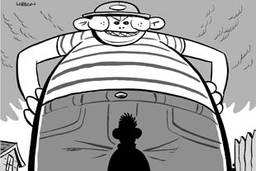What Not to Watch
Makeover shows like “What Not to Wear” teach women to listen to their inner demons
Lakshmi Chaudhry
Everyone knows fashion is pain, but on television it also involves a generous dose of emotional abuse. Not content with tormenting women with double-zero-sized clothing, arthritis-inducing stilettos, and the self-inflicted wedgie that is the thong, fashion experts have found a way to increase the level of violence: The makeover show.
On cable, shows that transform the average ugly duckling into a well-coiffed swan have become ubiquitous: “How Do I Look?” and “Look for Less” on Style Network, “Style by Jury” on Women’s Entertainment Network, and the over-hyped metrosexual sensation, “Queer Eye for the Straight Guy” on Bravo. And that doesn’t even include the innumerable makeover segments on talk shows hosted by the likes of Tyra or Oprah. With the exception of “Queer Eye,” these shows are aimed entirely at a female audience, and their promise is that anyone can be beautiful, irrespective of age, shape or size. There’s only one little catch: total public humiliation of the “lucky” fashion victim.
The reigning queen of the genre is BBC’s “What Not to Wear,” the enormous success of which in Britain has spawned numerous imitators across the pond, including its very own American edition on TLC. The show’s original hosts (who recently defected to ITV), Trinny Woodall and Susannah Constantine, struck gold by marrying the self-help narrative of personal empowerment to the dictatorial ethos of the fashion industry.
The show is based on the premise that women’s wardrobes reflect how they feel about themselves. Put simply, a woman who dresses bad is one who feels bad, so “What Not To Wear” is not just about changing how you look, but who you are. But the path to self-transformation bears an uncanny resemblance to the military boot camp. As one of the participants puts it, “They had to break me down in order to build me up again.” Becoming a strong, self-confident woman requires complete submission; the woman has to surrender her mind and soul along with her entire wardrobe.
The “breaking down” process entails ritual debasement in various forms, beginning with the painfully embarrassing “secret footage” taken by the unsuspecting woman’s family and friends, who have nominated her for the show. (Think shots of her ass stuffed into too-tight plaid trousers interspersed with those of her eight-year old telling the camera that she dresses like “a tramp.”)
The American version ups the ante by forcing the target to watch the “secret footage” in the company of their kith and kin, who join in the good, clean fun of comparing the chosen target to a “bobblehead,” traffic cone or stripper. The hosts, Clinton Kelly and Stacy London, deliver more of the same in-studio as the woman stands in front of a 360-degree mirror designed to reveal her body’s every flaw (“Why is your tummy hanging out?”), and as they throw her clothes into a giant trash can (“Is there a fashion jail? Because I’m horrified!”). More abuse comes later, as she stumbles through shops trying to find clothes that meet the proscribed list of “The Rules” (“You’re making me really angry,” says Kelly to a woman foolish enough to buy yet another piece of clothing in her favorite color, pink.)
While public humiliation is de rigeur for reality programming, what makes “What Not to Wear” painful to watch is that none of its participants resemble the attention-hungry contestants on “Survivor” or “Real World.” These are, for the most part, really nice women, many of whom are working moms with low-level white-collar jobs who simply don’t have the money or time to preen in front of the mirror.
As the 19th century U.S. sociologist Thorstein Veblen observed in his book, The Theory Of The Leisure Class, “[O]ur apparel is always in evidence and affords an indication of our pecuniary standing to all observers at first glance. … [D]ress, therefore, in order to serve its purpose effectively should not only be expensive, but it should also make plain to all observers that the wearer is not engaged in any kind of productive labour.” So it isn’t surprising that a number of the tips doled out by the experts have little connection to the real lives of the women they’re making over. When one woman refuses to buy “dryclean only” clothes, Kelly and London are dismissive and impatient. Fashion has always been about class in the literal sense, and aesthetics aside, the women’s greatest fashion crime seems to be that they aren’t rich.
Worse, the show pretends that the women’s emotional debasement is “for their own good” – just like the tough love meted out by a Marine drill sergeant. “What Not to Wear’s” distinctly military approach is all the more striking when compared to the maternal attitude of its male counterpart, “Queer Eye for the Straight Guy,” where male participants are instead coaxed, teased and gently jollied into changing their wicked sartorial ways. While “Queer Eye” does offer a message of self-improvement – “it’s you, only better” – it does not make the same connection between self-esteem and attire. When men dress badly, it’s because they’re clueless, lazy or just plain incompetent. Not only is their sense of self not invested in how they look, but the so-called “Fab Four” are careful to handle their male participants’ egos with appropriate care and respect.
Interestingly, the hosts of “What Not to Wear” also take a kinder, gentler approach in their rare shows featuring a man. The critique is far milder, and tempered by fulsome compliments: “You’re a well-formed young man;” “You’re a prime piece of beef.”
When it comes to women, however, the hosts assume that they have nothing to lose, especially their pride. After all, what self-respecting woman would match pink polka-dotted boots with an ill-fitting candy stripe dress? More importantly, the show reveals how so-called fashion gurus constantly reiterate the most retrograde ideas about femininity in the name of style. Women are continually derided for looking “slutty,” “cheap and nasty,” or “trashy,” and cautioned against “sending the wrong message” – even as the frumpy ones are urged to show more flesh. Host Jessica London’s favorite word is “appropriate,” because women need to look, and – by the show’s logic–be proper at all times.
What’s sad is just how eager the women are to be transformed even at the expense of their dignity. Each episode ends with the participant beaming in delight and gratitude at how wonderful they look and feel. This reveals the depressing reality that women are no strangers to shame, which is a constant presence lurking on the edges of our daily lives. All it takes is an incautious look in the mirror in the morning; a dress that won’t fit at the mall; a careless remark from a boyfriend. Being a feminist just redoubles the sense of failure, since the very experience of shame points to our inability to escape the binds of socialization.
All of us do a pretty good job of beating up on ourselves already; the mean, bullying voice of the makeover host is no more than an external manifestation of our inner critic. “What Not to Wear” offers its female audience a potent mixture of aspiration and schadenfreude. It makes us feel better about ourselves – “God, she looks like crap!” – even as it promises to free us from the pain of not meeting our culture’s punitive standards of beauty – “I could look hot too!” All we have to cede in return for this faux version of empowerment is our respect for our innermost selves.







